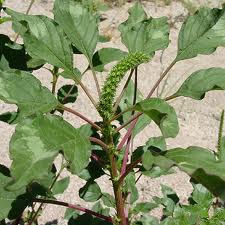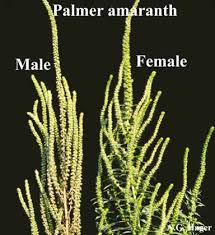As most of the corn has been harvested, UGA encourages producers to begin establishing a management plan to control Palmer amaranth (pigweed) populations. As we move into the fall of the year, we need to control the Palmer amaranth population, in order to prevent an additional crop of seed being produced prior to frost. It is important to remember that one female palmer amaranth plant can produce up to 460,000 seed and pollen from male plant can travel at least 1,000 ft. in the field to fertilize susceptible females.
The decrease in daylight hours actually speeds up the flowering and seed production of Palmer amaranth. During the fall season, Palmer amaranth will actually flower earlier than in the summer. Palmer amaranth will move from seed to flower in approximately three weeks resulting in seed production occurring two to three weeks later. Palmer amaranth plants that emerge, up until 35 days before frost, will have the potential to produce viable seed. For this reason, post-harvest populations should be managed up until this time. There can be some germination of seed at 41 degree Farenheit. For Brooks County, we typically plan on the first frost to occur mid to late November. This fall time frame, allows for Plamer amaranth plants emerging through mid October, to have potential to deposit additional seed into the soil.
However, we do have control options that we can incorporate into our long term control strategy. It is important to remember that viable Palmer amaranth seed can be produced within 2 weeks after pollen shed. So, control strategies need to be implemented before this time to be effective in reducing weed-seed deposit back into the field.
If the Palmer amaranth is larger than six inches there are no herbicide control options so mowing and/or tillage is recommended. But, if the Plamer amaranth is less than six inches we can consider herbicide control methods. If there is no plan to plant a small grain in the fall, we can use Dual Magnum/Stalwart, etc… with Gramaxone. Dual Magnum can be included with burndown treatment at rate of 1 pt/A to provide residual control. However, Dual Magnum will hurt small grains. So, if a small grain is to be planted consider other tank mix options with Gramaxone. Dependent upon, the crops that remain in the field and that are located in the surrounding area, 2,4D or dicamba may be a tank mix partner, with Gramaxone @ 32oz/A and 2,4D amine @16-24oz/A . But, if cotton is nearby and/or drift is a concern, consider using Clarity @ 8oz/A instead of 2,4D. The planting of small grains should be delayed for at least seven days for each 16 oz/A of 2,4D applied or 15 days for each 8 oz/A of Clarity applied.
Unfortunately, we are all aware that we do not have a quick, easy fix to eliminate Palmer amaranth. But, we must implement a long term control strategy to attempt and obtain a manageable field situation for next season. We need to continue to have an active Palmer amaranth control program up until frost.


